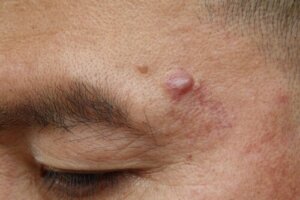Reasons for a Hard Lump Under the Skin


Reviewed and approved by the nurse Leidy Mora Molina
A hard lump under the skin can alarm anyone. The greatest fear is that it might be a malignant tumor, but this is hardly ever the case. There are many reasons why this occurs and most of them shouldn’t cause concern.
It’s true that a hard lump under the skin can be a sign of cancer. However, it’s almost always due to other reasons. If it appears abruptly, within 24 to 48 hours, and causes pain, it’s most likely an infection or injury.
When it’s a soft, smooth lump that can be moved with the fingers, it’s usually a benign cyst. Therefore, before jumping to the wrong conclusions, it’s best to evaluate whether a hard lump under the skin should be a cause for concern or not.
What can cause a hard lump under the skin?

A hard lump under the skin can be caused by many factors. Below we will see what the main causes of this are, and what characteristics can help us differentiate some lumps from others.
Swollen lymph node
Lymph nodes are small glands that are part of the immune system. Their role is to filter out harmful substances in the lymphatic fluid. The lymph nodes also store white blood cells that fight infection.
It’s common for inflammation to occur in the lymph nodes when there is a viral or bacterial infection. Such swelling usually occurs in areas such as the head, neck, armpits or groin.
They usually feel hard and painful to the touch. When the hardness is noticeable and they appear elastic or immobile, it may be a sign of a more serious health problem. Diseases such as lymphoma, leukemia, and breast cancer can affect the nodes.
A cyst
A cyst also forms a hard lump under the skin. The texture depends on the material left inside the lump. When it has a hard consistency, it contains trapped proteins or dead skin cells.
If they are close to the surface of the skin, they will most likely feel soft. If they are located in deeper areas, they will be hard. They usually appear on the hands and wrists, spine, scalp, feet, toes, or mouth.
Most often they disappear on their own after a while. Sometimes they have a black spot in the center and then they usually explode, releasing a yellow substance. If they are red, swollen or painful, medical intervention may be required.
Read also: Treatments for Controlling Breast Cysts
Lipoma
A fat-containing tumor is called a lipoma. It may be a hard lump under the skin, but most commonly feels soft and movable. It looks pale or colorless and usually doesn’t cause any other symptoms.
The exact cause of lipomas isn’t known. They rarely cause problems unless they involve nerves or blood vessels. In those cases, they may cause pain. They usually don’t require medical treatment unless they cause discomfort.
Hard lump under the skin: the dermatofibroma
Dermatofibroma is a hard brown or red lump under the skin. It most commonly appears in areas that are exposed, such as the legs, arms, or back. It usually causes no symptoms, but, in some cases, there may be itching, irritation, and pain.
These bumps appear when excess cells accumulate in the dermis, which is the thickest layer of the skin. It’s unknown what causes these formations, which are never cancerous. However, they remain on the skin for the rest of the person’s life. There are surgical options to remove them.
Fibroadenoma
Fibroadenoma is a benign breast tumor. It is made up of fibrous and glandular tissues. It develops when there are high estrogen levels and can grow when hormone levels increase in pregnancy. At menopause it tends to decrease.
These types of lumps are most common in women in their 20s and 30s. However, they can appear at any age. The fibroadenoma feels hard, but is movable.
If it causes pain, is accompanied by changes in the appearance of the breast, or the person has a family history of breast cancer, a visit to the doctor is recommended. In fact, whenever this type of lump appears, it’s worth consulting a physician.
Other types of hard lump under the skin
Sometimes a hard lump under the skin is a boil. This is a red, painful bump that usually involves one or more infected hair follicles. It could also be a mole.
A wart also forms a hard bump under the skin that is also rough. It has black dots and usually appears on the hand or foot. Calluses also thicken the skin and form hard bumps.
Abscesses, on the other hand, are soft bumps because they contain infected fluid. If there is a pigmented or colored spot in the bump that changes shape or size, bleeds easily, crusts over, and doesn’t heal, it’s advisable to consult a doctor as soon as possible.
When is it necessary to see a doctor?
If you find a lump on your body, it’s advisable to consult a doctor.
A doctor should be consulted whenever a hard lump that raises doubts or concerns appears under the skin. The fact that they’re hard or rigid may be a sign of a health problem that cannot be detected with the naked eye. This recommendation should be strongly considered if other signs such as the following are also present:
- Changes in the size or appearance of the lump
- The lump is stiff and causes pain or tenderness
- The lump looks red or swollen
- There is unintentional weight loss
Discover: Acne Scars and Skin Health
Diagnosis
To make a diagnosis of a hard lump under the skin, the doctor will most likely conduct an initial interview about personal and family health history. He or she will inquire about how long it has been there and whether it has changed.
They will then usually perform a physical examination in which the lump is pinched or removed. After this, they may order some tests such as the following:
- Imaging. These may be MRIs, ultrasounds or x-rays.
- Blood tests. White blood cell count and hormone levels are evaluated.
- Needle biopsy. A tissue sample is taken for analysis under a microscope.
What to remember:
A hard lump under the skin is not a sign of cancer by itself. As we have seen, there are many reasons why these lumps can appear and most of the time they are not related to cancer.
That said, it’s also important to note that it isn’t a good idea to ignore these lumps. If you are concerned, and especially if they show changes or are accompanied by other symptoms, it is best to consult your doctor.
All cited sources were thoroughly reviewed by our team to ensure their quality, reliability, currency, and validity. The bibliography of this article was considered reliable and of academic or scientific accuracy.
- Luna, M. L., Viedma, A. J., Fuentes, A. M., Ruiz, A. B., Flores, P. B., & Santos, J. C. (2013). Dermatofibroma gigante, una variante infrecuente de dermatofibroma. Medicina Cutánea Ibero-Latino-Americana, 41(6), 267-270.
- Aliaga, M. N., Ibarra, V. A., Neira, V. P., & Contreras, M. L. (2010). Fibroadenoma en mama axilar supernumeraria; reporte de un caso. Revista Médica Clínica Las Condes, 21(2), 329-333.
- Faytong, M. S., Chávez, I. A. T., & Urrea, H. E. R. (2020). FACTORES DE RIESGO QUE PREDISPONEN A LA APARICIÓN DEL CANCER DE PIEL UN ESTUDIO DE REVISIÓN. Más Vita, 2(3 Extraord), 97-103.
This text is provided for informational purposes only and does not replace consultation with a professional. If in doubt, consult your specialist.








